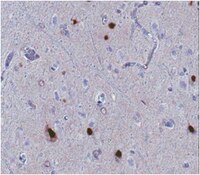MABN102 Sigma-AldrichAnti-ARX Antibody, clone 11F6.2
Detect ARX using this Anti-ARX Antibody, clone 11F6.2 validated for use in Western Blotting, IHC(P).
More>> Detect ARX using this Anti-ARX Antibody, clone 11F6.2 validated for use in Western Blotting, IHC(P). Less<<Recommended Products
Overview
| Replacement Information |
|---|
Key Spec Table
| Species Reactivity | Key Applications | Host | Format | Antibody Type |
|---|---|---|---|---|
| H | WB, IH(P) | M | Purified | Monoclonal Antibody |
| References |
|---|
| Product Information | |
|---|---|
| Format | Purified |
| Control |
|
| Presentation | Purified mouse monoclonal IgG1κ in buffer containing 0.1 M Tris-Glycine (pH 7.4), 150 mM NaCl with 0.05% sodium azide. |
| Quality Level | MQ100 |
| Physicochemical Information |
|---|
| Dimensions |
|---|
| Materials Information |
|---|
| Toxicological Information |
|---|
| Safety Information according to GHS |
|---|
| Safety Information |
|---|
| Storage and Shipping Information | |
|---|---|
| Storage Conditions | Stable for 1 year at 2-8°C from date of receipt. |
| Packaging Information | |
|---|---|
| Material Size | 100 µg |
| Transport Information |
|---|
| Supplemental Information |
|---|
| Specifications |
|---|
| Global Trade Item Number | |
|---|---|
| Catalogue Number | GTIN |
| MABN102 | 04053252549694 |
Documentation
Anti-ARX Antibody, clone 11F6.2 SDS
| Title |
|---|
Anti-ARX Antibody, clone 11F6.2 Certificates of Analysis
| Title | Lot Number |
|---|---|
| Anti-ARX, clone 11F6.2 - 2202479 | 2202479 |
| Anti-ARX, clone 11F6.2 - 2287778 | 2287778 |
| Anti-ARX, clone 11F6.2 - 2562846 | 2562846 |
| Anti-ARX, clone 11F6.2 - 3270753 | 3270753 |
| Anti-ARX, clone 11F6.2 - 3385841 | 3385841 |
| Anti-ARX, clone 11F6.2 - 3557822 | 3557822 |
| Anti-ARX, clone 11F6.2 - 3729434 | 3729434 |
| Anti-ARX, clone 11F6.2 - 3878290 | 3878290 |
| Anti-ARX, clone 11F6.2 - 3934812 | 3934812 |
| Anti-ARX, clone 11F6.2 - 4027747 | 4027747 |
Brochure
| Title |
|---|
| New Products: Volume 3, 2012 |















